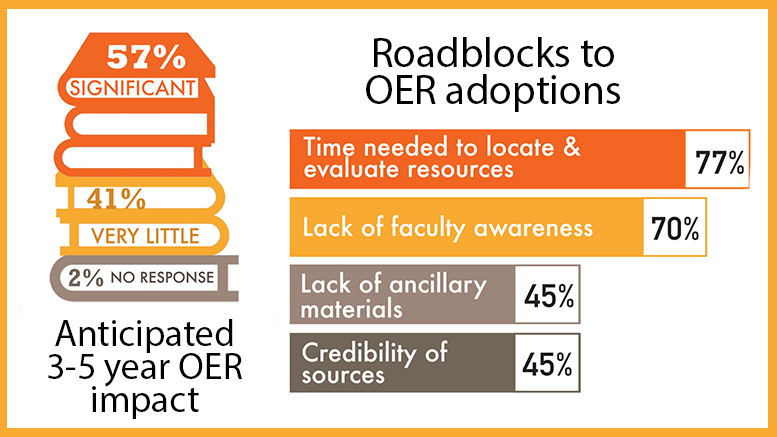Open educational resources (OERs) are expected to have a growing impact on community colleges, according to an annual survey.
The anticipated effect of OERs on two-year college campuses has steadily increased from 36 percent in 2012 to 57 percent in 2016, shows an Instructional Technology Council (ITC) survey of its member colleges. ITC is an affiliated council of the American Association of Community Colleges.
The top challenges to using OERs according to survey respondents, who are typically e-learning administrators, are:
- time needed to locate/evaluate resources (76 percent)
- lack of faculty awareness (70 percent)
- lack of ancillary materials (45 percent)
- credibility of sources (45 percent)
- resistance from administration (10 percent)
Time needed to locate/evaluate resources has been the top reported barrier to OERs since ITC has included it in its surveys in 2012.
“Further buy-in from educators will lead to further progress in the use of OERs in higher education,” the report said.
Lukewarm about MOOCs
The popularity of massive open online classes (MOOCs) among community colleges never really took off like it did among four-year institutions. For the past five years, community colleges have shown little interest in creating or incorporating MOOCs into their distance education programs, the survey report said.
According to the survey:
- 78 percent of respondents indicated they have no plans to offer MOOCs
- 16 percent indicated they currently offer MOOCs
- 5 percent indicated they plan to offer MOOCs in the next two years.
“Community colleges have historically favored offering more personalized instruction to a small cadre of students,” the survey report said. “They tend to hesitate before offering courses to large class sizes, regardless of their delivery mode.”
Although, the MOOC movement has generally subsided, some community colleges are using and/or creating MOOCs for student orientations, remedial education and increasingly as a marketing tool to K-12 students and the community.
The annual survey also looks at enrollment for online courses, administrative challenges, and staff professional development/training, among other areas related to e-learning.

